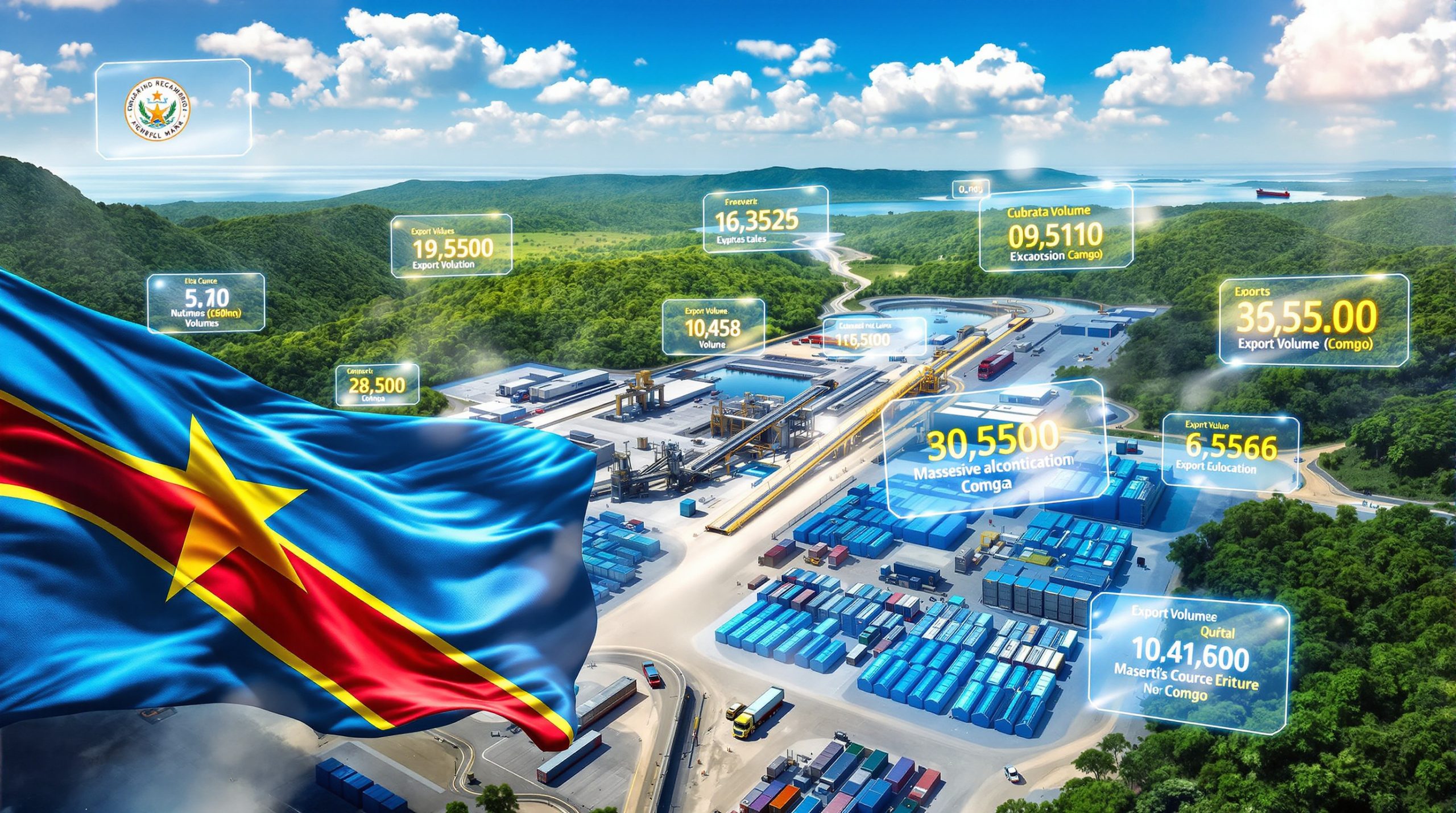Indonesia's tin mining sector stands poised for a dramatic recovery by 2026, following governmental enforcement actions that reshaped the country's production landscape in 2024. The world's second-largest tin producer experienced significant disruptions when regulatory crackdowns targeted illegal mining operations, creating ripple effects across global tin prices and setting the stage for systematic industry transformation.
What Factors Are Driving Indonesia's Tin Production Recovery Timeline?
Government Enforcement Actions That Reshaped the Industry
Indonesian authorities implemented comprehensive enforcement measures throughout 2024, fundamentally altering the tin mining landscape. These regulatory interventions targeted unlicensed operations that had dominated significant portions of the industry, creating substantial market disruptions while establishing foundations for legitimate production growth.
The enforcement campaign's magnitude became evident through its global market impact, with tin prices experiencing upward pressure as Indonesian supply constraints affected international availability.
The crackdown's effectiveness demonstrated the government's commitment to formalizing the sector, though it temporarily reduced overall production capacity. Furthermore, understanding mining permits basics became crucial for operators seeking compliance. Key enforcement measures included:
• Closure of unlicensed smelting facilities across tin-producing regions
• Enhanced monitoring of mining concessions and production reporting
• Strengthened penalties for operators violating environmental and safety standards
• Implementation of digital tracking systems for tin concentrate movements
| Operation Type | Market Impact | Regulatory Status |
|---|---|---|
| Licensed Operations | Maintained production with compliance costs | Fully operational under enhanced oversight |
| Unlicensed Smelters | Production halted pending certification | Temporary closure or permanent shutdown |
| Informal Mining | Transition to formal structures required | Integration into licensed operations |
The Role of State-Owned PT Timah in Market Stabilization
PT Timah, Indonesia's state-owned mining enterprise, emerged as a central figure in the recovery strategy. The company assumed control of previously seized facilities, implementing technical upgrades and sustainability improvements to restore production capacity under proper regulatory frameworks.
The state enterprise's operational restart phases follow a systematic approach. Modern companies increasingly rely on modern mine planning techniques to optimise operations:
- Facility Assessment Phase: Technical evaluation of seized smelting operations
- Infrastructure Modernization: Equipment upgrades and safety system installation
- Workforce Training: Personnel certification for updated operational standards
- Production Resumption: Gradual capacity increases with quality monitoring
This structured approach aims to ensure sustainable production increases while maintaining compliance with Indonesia's evolving regulatory framework. The systematic restart of operations under state oversight provides stability that private sector transitions might lack during regulatory uncertainty periods.
How Will Indonesia's Position as World's Second-Largest Tin Producer Change by 2026?
Current Market Disruptions and Supply Chain Bottlenecks
Indonesia's enforcement actions created measurable impacts on global tin availability, with international prices rising as supply constraints affected market equilibrium. The country's significant role in global tin production became particularly evident when regulatory changes influenced worldwide pricing dynamics.
| Year | Production Status | Market Impact | Recovery Indicator |
|---|---|---|---|
| 2024 | Enforcement disruptions | Rising global prices | Regulatory framework establishment |
| 2025 | Transition period | Market adjustment | Licensed operations scaling |
| 2026 | Projected normalization | Price stabilisation expected | Full capacity restoration target |
The supply chain disruptions highlighted Indonesia's critical position in international tin markets. Global manufacturers dependent on Indonesian tin experienced procurement challenges, emphasising the country's strategic importance in critical minerals supply chains.
Export patterns during the transition period reflected the enforcement impact, with legitimate operations maintaining international sales while unlicensed producers faced market exclusion. This created temporary supply gaps that legal operators gradually filled as capacity expanded.
Comparative Analysis with Other Major Tin-Producing Nations
Indonesia's regulatory transformation occurs within a global context where other major producers face their own production challenges. China, the world's largest tin producer, continues dominating global output, while countries like Myanmar experience political instability affecting their mining sectors.
Indonesia's systematic approach to industry formalisation contrasts with the volatility experienced by other regional producers, potentially strengthening its competitive position through regulatory certainty.
The country's recovery timeline suggests improved market share stability compared to regions experiencing ongoing disruptions. Peru and other Latin American producers maintain steady output, but Indonesia's large-scale capacity and strategic location provide advantages for Asian market supply.
Additionally, these industry evolution trends suggest Indonesia's regulatory improvements may attract international investment previously deterred by informal sector prevalence, potentially enhancing long-term production capacity beyond 2026 recovery targets.
What Economic Impacts Will Normal Production Levels Create?
Revenue Recovery Projections for State Mining Operations
The normalisation of Indonesian tin output presents substantial economic implications for both state enterprises and government revenues. PT Timah's expanded role in managing previously unlicensed operations creates opportunities for improved fiscal contributions through formal taxation and royalty systems.
State mining operations benefit from several revenue enhancement factors:
- Elimination of illegal competition reducing market share erosion
- Enhanced pricing power through quality certification and reliable supply
- Operational efficiency gains from modern equipment and processes
- Export revenue optimisation through direct international sales channels
Government fiscal benefits extend beyond direct mining revenues to include:
• Increased corporate tax collections from formalised operations
• Enhanced export duty receipts from legitimate trade channels
• Reduced enforcement costs as compliance rates improve
• Employment tax revenues from formal sector job creation
International Market Price Stabilisation Effects
Indonesia's production recovery contributes to global tin market equilibrium through several mechanisms. Supply reliability improvements reduce price volatility that characterised periods of regulatory uncertainty, benefiting both producers and consumers in international markets.
| Market Factor | 2024 Impact | 2026 Projection | Stabilisation Effect |
|---|---|---|---|
| Supply Reliability | Disrupted by enforcement | Normalised operations | Reduced price volatility |
| Production Capacity | Temporarily reduced | Restored to full levels | Market equilibrium support |
| Export Consistency | Affected by transitions | Regular shipment schedules | Supply chain predictability |
Global manufacturers benefit from normalised Indonesian supply through improved procurement planning and cost management. The electronics industry, renewable energy sector, and automotive manufacturing all depend on consistent tin availability for production processes. However, these commodity prices impact mining operations significantly.
Disclaimer: Future price projections depend on multiple global factors including demand patterns, alternative supply sources, and economic conditions that may affect actual market outcomes.
Which Regulatory Changes Are Enabling the 2026 Recovery?
Modernisation of Indonesia's Tin Mining Framework
Indonesia's regulatory transformation encompasses comprehensive updates to mining law enforcement, environmental standards, and operational requirements. These changes create sustainable frameworks for long-term sector development while addressing previous governance gaps.
New compliance standards for smelting operations include:
• Environmental monitoring systems with real-time emissions tracking
• Worker safety protocols meeting international mining industry standards
• Production reporting requirements using digital verification systems
• Quality certification processes ensuring product specifications meet export standards
The modernised framework addresses sustainability concerns that previously limited international investment and market access. Environmental protocol upgrades align Indonesian operations with global best practices, potentially opening new market opportunities.
Consider a reformed smelting facility example: A previously unlicensed operation undergoes complete technological upgrading, installing emissions control systems, worker safety equipment, and digital monitoring capabilities. Post-reformation, the facility operates with full environmental compliance, employs certified technical staff, and maintains production quality meeting international standards.
Dismantling Illegal Mining Networks
Indonesia's enforcement success required systematic approaches to eliminate informal mining networks that previously dominated significant production portions. The transformation addressed both operational and economic aspects of illegal mining prevalence.
Statistical analysis suggests informal operations comprised substantial portions of total tin production prior to enforcement actions, highlighting the scale of regulatory transformation required.
| Mining Sector Component | Pre-Enforcement Status | Post-Enforcement Target | Transition Support |
|---|---|---|---|
| Licensed Operations | Limited market share | Dominant production role | Capacity expansion support |
| Informal Mining | Widespread prevalence | Integrated into formal sector | Community transition programs |
| Regulatory Compliance | Inconsistent enforcement | Systematic monitoring | Enhanced oversight systems |
Long-term sustainability measures address the social and economic needs of communities previously dependent on informal mining. These programs aim to provide alternative livelihoods while maintaining regional economic activity through legitimate channels.
What Challenges Could Delay Indonesia's Tin Output Normalisation?
Social and Economic Tensions in Mining Communities
The transition from informal to formal mining structures creates potential social challenges in communities historically dependent on unlicensed operations. Small-scale miners face adaptation requirements that may affect regional employment patterns and economic stability.
Community transition programs represent critical components of successful sector formalisation, requiring careful balance between regulatory enforcement and social welfare considerations.
Regional employment considerations in tin-producing areas include:
• Job transition support for workers from closed illegal operations
• Skills training programmes preparing workers for formal sector employment
• Economic diversification initiatives reducing community dependence on mining
• Social safety net provisions during transition periods
The Bangka Belitung Islands, Indonesia's primary tin production region, face particular adaptation challenges as communities adjust to new regulatory requirements. Successful transition depends on effective coordination between government agencies, formal mining companies, and local communities.
Technical and Infrastructure Hurdles
Restarting seized smelting operations requires addressing multiple technical challenges beyond basic facility repairs. Infrastructure modernisation, quality control implementation, and international certification achievement all present potential timeline extensions.
Critical milestones for smelter operational readiness include:
- Equipment inspection and repair addressing deferred maintenance issues
- Environmental systems installation meeting updated compliance standards
- Workforce certification completion for technical and safety positions
- Quality control system implementation ensuring product specifications
- International certification achievement enabling export market access
| Infrastructure Component | Investment Requirements | Timeline Factors | Risk Factors |
|---|---|---|---|
| Smelting Equipment | Modernisation and maintenance | 6-12 months per facility | Technical complexity |
| Environmental Systems | Emissions control installation | 3-6 months implementation | Regulatory approval |
| Quality Control | Laboratory and testing setup | 2-4 months establishment | Certification requirements |
International certification requirements present additional complexity as Indonesian operations seek market access. Meeting specifications for electronics-grade tin requires precise process control and quality assurance systems that may require extended implementation periods.
How Will Global Tin Markets Respond to Indonesia's Production Recovery?
Supply Chain Reliability Improvements for International Buyers
Indonesia's normalised tin production offers significant advantages for global supply chain management. International buyers benefit from reduced procurement uncertainty and improved delivery reliability as legitimate operations replace irregular informal suppliers.
Key benefits of normalised Indonesian tin supply include:
• Predictable delivery schedules supporting manufacturing planning
• Quality consistency meeting technical specifications
• Contract reliability through established legal frameworks
• Price stability reducing procurement cost volatility
Manufacturing sector implications vary by industry segment. Electronics manufacturers require high-purity tin for soldering applications, while renewable energy sector growth increases demand for tin-containing photovoltaic cells and energy storage systems.
Industries most affected by tin supply stability:
• Electronics manufacturing: Circuit board assembly and component production
• Automotive sector: Electric vehicle battery systems and electronic components
• Renewable energy: Solar panel manufacturing and energy storage applications
• Packaging industry: Tin-plated steel for food and beverage containers
Strategic Importance for Critical Minerals Security
Indonesia's tin production recovery contributes to global critical minerals supply security amid increasing international competition for strategic resources. The country's reliable production capacity reduces supply concentration risks that affect consuming nations' economic security.
Consider the impact analysis of sustained production normalisation: International buyers gain access to diversified supply sources, reducing dependence on single-country suppliers. This diversification strengthens supply chain resilience against geopolitical disruptions or natural disasters affecting other producing regions.
| Industrial Sector | 2025 Tin Demand | 2030 Projection | Indonesia Supply Role |
|---|---|---|---|
| Electronics | Stable growth | Moderate increase | Primary supplier for Asian markets |
| Automotive | Rapid expansion | Significant growth | Critical for EV manufacturing |
| Renewable Energy | Strong growth | Accelerated demand | Strategic supply security |
| Traditional Applications | Steady demand | Gradual increase | Consistent market supply |
Furthermore, according to PT Timah's production targets, Indonesia's strategic location provides logistical advantages for Asian manufacturing centres while maintaining global market access through established shipping routes. The country's production recovery strengthens regional supply chains while contributing to worldwide market stability.
Disclaimer: Demand projections reflect current market trends and may be affected by technological developments, economic conditions, and policy changes that could alter actual consumption patterns.
What Investment Opportunities Emerge from Indonesia's Tin Sector Restructuring?
State-Led Infrastructure Development Projects
Indonesia's tin sector transformation creates investment opportunities through state-led modernisation initiatives. PT Timah's expansion plans and facility upgrades require substantial capital investments in equipment, technology, and infrastructure development.
The state enterprise's modernisation programme represents systematic investment in processing capabilities, environmental systems, and operational efficiency improvements that support long-term production growth.
Technology upgrades in processing and refining capabilities focus on:
• Automated production systems improving operational efficiency
• Environmental control technologies ensuring regulatory compliance
• Quality assurance equipment meeting international standards
• Digital monitoring systems supporting production optimisation
Key investment phases supporting production recovery:
- Emergency facility repairs addressing immediate operational requirements
- Equipment modernisation installing current-generation processing technology
- Environmental system upgrades ensuring long-term compliance
- Capacity expansion projects increasing total production capability
International Partnership Potential
Indonesia's regulatory improvements create opportunities for international partnerships in compliant mining operations. Foreign investment previously deterred by informal sector prevalence may increase as regulatory clarity and operational transparency improve.
| Investment Framework | Pre-Reform Conditions | Post-Reform Opportunities | Risk Considerations |
|---|---|---|---|
| Foreign Direct Investment | Limited by regulatory uncertainty | Enhanced through compliance clarity | Political and regulatory stability |
| Technology Partnerships | Constrained by informal operations | Expanded through legitimate channels | Technical implementation challenges |
| Market Access | Affected by quality inconsistency | Improved through certification systems | International competition |
Due diligence considerations for international investors include:
• Environmental compliance verification ensuring regulatory adherence
• Social impact assessment evaluating community relations
• Technical capability evaluation confirming operational competency
• Market position analysis assessing competitive advantages
International partnership frameworks benefit from Indonesia's improved regulatory environment while requiring careful evaluation of operational capabilities and market positioning within the reformed sector structure.
Frequently Asked Questions About Indonesia's Tin Production Recovery
When exactly will Indonesia's tin output return to pre-2024 levels?
President Prabowo Subianto announced in October 2025 that Indonesia tin output back to normal 2026 represents the government's target timeline. However, specific monthly milestones or exact production volume targets were not detailed in the presidential statement, suggesting the recovery timeline may depend on technical implementation progress and facility readiness assessments.
What percentage of global tin supply does Indonesia typically provide?
While Indonesia maintains its position as the world's second-largest tin producer, specific current market share percentages require verification from recent geological survey data and international mining statistics. The country's global supply contribution varies based on production levels and international demand patterns.
How will the crackdown on illegal mining affect local communities?
Local communities previously dependent on informal mining operations face transition challenges requiring coordinated support programmes. Government initiatives aim to provide alternative employment opportunities and economic diversification options, though specific programme details and implementation timelines need further documentation from Indonesian authorities.
What are the main technical challenges in restarting seized smelters?
Seized smelter operations require comprehensive technical upgrades including equipment maintenance, environmental system installation, and quality control implementation. International certification requirements add complexity as facilities must meet export standards while complying with updated Indonesian regulatory frameworks. Worker training and safety system implementation represent additional operational preparation requirements.
Conclusion: Indonesia's Path to Tin Production Normalisation
Key Milestones to Monitor Through 2026
Indonesia's tin sector recovery follows a systematic path toward Indonesia tin output back to normal 2026 as announced by President Prabowo Subianto. The transformation from enforcement-disrupted operations to normalised production represents significant progress in formalising the industry structure.
| Timeline Marker | Recovery Indicator | Market Impact | Monitoring Metric |
|---|---|---|---|
| Q1 2025 | Facility assessments completion | Limited production increases | PT Timah operational reports |
| Q2-Q3 2025 | Technical upgrades implementation | Gradual supply improvements | Export volume statistics |
| Q4 2025 | Certification processes | Market confidence building | International price stability |
| 2026 | Full normalisation target | Supply chain reliability | Production volume recovery |
Government commitment at presidential level indicates high-priority status for tin sector normalisation, suggesting resource allocation and policy coordination supporting recovery timeline achievement.
Critical normalisation indicators include production volume restoration, export consistency improvement, and price volatility reduction in international markets. Indonesia tin output back to normal 2026 requires successful coordination between regulatory enforcement, technical implementation, and community transition support.
Long-term implications for global tin market stability extend beyond immediate supply recovery to include supply chain diversification benefits, quality standardisation improvements, and strategic minerals security enhancement. Additionally, Indonesian quotas reduced by one year demonstrate the government's commitment to systematic approach to sector formalisation provides a framework for sustainable production growth supporting both domestic economic development and international market requirements.
The country's recovery timeline demonstrates that comprehensive regulatory transformation, while initially disruptive, creates foundations for improved market stability and sustainable industry development. Success in achieving Indonesia tin output back to normal 2026 would establish Indonesia as a model for critical minerals sector formalisation in developing economies.
Disclaimer: This analysis is based on available information as of October 2025. Actual recovery timelines may vary depending on technical implementation progress, regulatory developments, and global market conditions that could affect projected outcomes.
Looking to Capitalise on Indonesia's Tin Market Recovery?
Indonesia's systematic approach to formalising its tin sector creates compelling opportunities for investors seeking exposure to critical minerals markets. Discovery Alert's proprietary Discovery IQ model delivers real-time alerts on significant ASX mineral discoveries, instantly empowering subscribers to identify actionable opportunities ahead of the broader market through comprehensive mining sector coverage.




